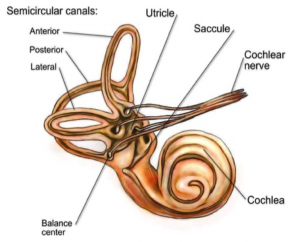Vertigo, the feeling that you are moving even though you aren’t, is an unpleasant yet common experience caused by a variety of conditions. It may surprise you to learn that in some cases your physiotherapist is actually able to treat vertigo.
Our brain’s ability to tell if we are moving or still is a complex process involving many different parts of the nervous system. The inner ear plays a very important role, with 3 semi-circular canals being responsible for gathering information about head movement. The vestibulocochlear nerve (remember that for quiz nights!) relays that information back to the brain where it is processed. Certain conditions can interrupt the smooth transition of that message, causing the brain to perceive movement when there is none. Physiotherapists may be able to help with a certain kind of vertigo called Benign Paroxysmal Positional Vertigo.
Commonly referred to as BPPV or positional vertigo, sufferers will only feel dizzy when their head moves in certain positions or directions. Most people complain of dizziness and nausea when rolling over in bed or when looking upwards. Other symptoms may include disturbance of balance and lightheadedness. BPPV can occur for no reason, however it has been noticed more commonly following a recent head trauma, previous bouts of vertigo, recent respiratory infections or recent travel on an airplane. All of these conditions have the ability to disrupt the inner ear’s normal function.
The odd symptom pattern of BPPV can be explained by a disruption in the signal sent by the semicircular canals off the inner ear to the brain.
Each of the three canals is positioned in a different direction and filled with fluid. As your head moves, the fluid in each of the canals moves slightly differently depending on the orientation of your head. Receptors are able to pick up that movement direction and speed, sending that message to the brain.
Sometimes, small calcium crystals, which typically form and reside in the space where all three semi-circular canals meet, called the utricle, escape and become lodged within the semi-circular canals. This causes disruption to the free-flowing fluid, and obscures the messages being sent to the brain.
If your doctor has diagnosed you with BPPV, they or your physiotherapist will be able to show you a series of movements, which can be done to assist in dislodging and moving the calcium crystals away from the semi-circular canal. You may be asked to perform exercises to keep the crystals from returning as well. In most instances, only one or two treatments are required for resolution of symptoms, however some cases require more.
If you think you have vertigo, it is necessary to be assessed by a medical professional, as your symptoms may be caused by any number of conditions and require correct diagnosis prior to treatment.
PhysioTip
Balance and stability are important skills that can help to prevent injury. Can you stand on one leg for 30 seconds without falling or wavering?


